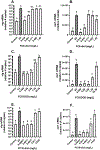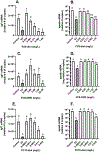Verification of In Vivo Estrogenic Activity for Four Per- and Polyfluoroalkyl Substances (PFAS) Identified as Estrogen Receptor Agonists via New Approach Methodologies
- PMID: 36800546
- PMCID: PMC10898820
- DOI: 10.1021/acs.est.2c09315
Verification of In Vivo Estrogenic Activity for Four Per- and Polyfluoroalkyl Substances (PFAS) Identified as Estrogen Receptor Agonists via New Approach Methodologies
Abstract
Given concerns about potential toxicological hazards of the thousands of data-poor per- and polyfluorinated alkyl substances (PFAS) currently in commerce and detected in the environment, tiered testing strategies that employ high-throughput in vitro screening as an initial testing tier have been implemented. The present study evaluated the effectiveness of previous in vitro screening for identifying PFAS capable, or incapable, of inducing estrogenic responses in fish exposed in vivo. Fathead minnows (Pimephales promelas) were exposed for 96 h to five PFAS (perfluorooctanoic acid [PFOA]; 1H,1H,8H,8H-perfluorooctane-1,8-diol [FC8-diol]; 1H,1H,10H,10H-perfluorodecane-1,10-diol [FC10-diol]; 1H,1H,8H,8H-perfluoro-3,6-dioxaoctane-1,8-diol [FC8-DOD]; and perfluoro-2-methyl-3-oxahexanoic acid [HFPO-DA]) that showed varying levels of in vitro estrogenic potency. In agreement with in vitro screening results, exposure to FC8-diol, FC10-diol, and FC8-DOD caused concentration-dependent increases in the expression of transcript coding for vitellogenin and estrogen receptor alpha and reduced expression of insulin-like growth factor and apolipoprotein eb. Once differences in bioconcentration were accounted for, the rank order of potency in vivo matched that determined in vitro. These results provide a screening level benchmark for worst-case estimates of potential estrogenic hazards of PFAS and a basis for identifying structurally similar PFAS to scrutinize for putative estrogenic activity.
Keywords: PFAS; adverse outcome pathway; ecotoxicology; endocrine disruption; new approach methodologies.
Figures



References
-
- Ankley GT, Cureton P, Hoke RA, Houde M, Kumar A, Kurias J, Lanno R, McCarthy C, Newsted J, Salice CJ, Sample BE, Sepulveda MS, Steevens J and Valsecchi S. 2021. Assessing the ecological risks of per- and polyfluoroalkyl substances: Current state-of-the science and a proposed path forward. Environ Toxicol Chem 40:564–605. - PMC - PubMed
-
- Interstate Technology Regulatory Council (ITRC). 2020. History and use of per-and polyfluoroalkyl substances (PFAS). https://pfas-1.itrcweb.org/fact_sheets_page/PFAS_Fact_Sheet_History_and_...
-
- De Silva AO, Armitage JM, Bruton TA, Dassucao C, Helger-Bernays W, Hu XC, Karrmon A, Kelly B, Ng C, Robuck A, Sun M, Webster TF, and Sunderland EM. 2021. PFAS exposure pathways for humans and wildlife: A synthesis of current knowledge and key gaps in understanding. Environ Toxicol Chem 40:631–657. - PMC - PubMed
-
- Patlewicz G, Richard AM, Williams AJ, Grulke CM, Sams R, Lambert J, Noyes PD, DeVito MJ, Hines RN, Strynar M, Guiseppi-Elie A, Thomas RS. A Chemical Category-Based Prioritization Approach for Selecting 75 Per- and Polyfluoroalkyl Substances (PFAS) for Tiered Toxicity and Toxicokinetic Testing. Environ Health Perspect. 2019. Jan;127(1):14501. doi: 10.1289/EHP4555. - DOI - PMC - PubMed
Publication types
MeSH terms
Substances
Grants and funding
LinkOut - more resources
Full Text Sources

